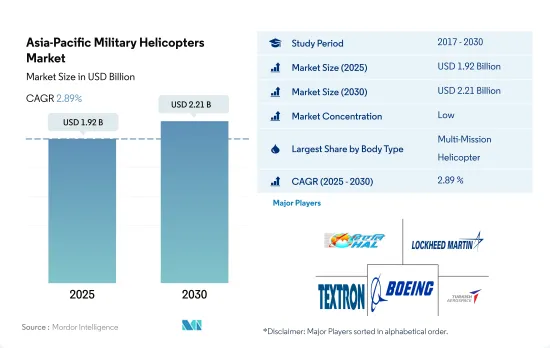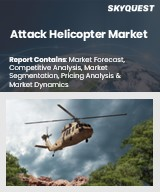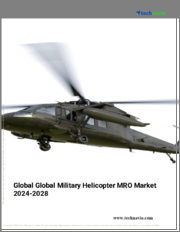
|
시장보고서
상품코드
1693583
아시아태평양의 군용 헬리콥터 시장 : 점유율 분석, 산업 동향 및 통계, 성장 예측(2025-2030년)Asia-Pacific Military Helicopters - Market Share Analysis, Industry Trends & Statistics, Growth Forecasts (2025 - 2030) |
||||||
■ 보고서에 따라 최신 정보로 업데이트하여 보내드립니다. 배송일정은 문의해 주시기 바랍니다.
아시아태평양의 군용 헬리콥터 시장 규모는 2025년 19억 2,000만 달러로 추정되며, 예측 기간 중(2025-2030년) CAGR 2.89%로 성장하고, 2030년에는 22억 1,000만 달러에 달할 것으로 예측됩니다.

조달 수가 많기 때문에 멀티 미션 헬리콥터가 회전익기 부문의 주류가 될 전망
- 회전익기 수요는 군사분쟁, 테러, 국경분쟁, 영토침범, 위반행위 증가에 의해 부추겨지고 있습니다.
- 2022년에는 이 지역의 항공기 납입 총수의 52%를 회전익기가 차지했습니다.
- 아시아태평양에서는 중국, 일본, 인도가 예측 기간 동안 대부분의 헬리콥터를 구입할 것으로 예상되고 있습니다. 인도는 MH-60R 24기, Dhruv ALH 34기, SA-315 26기, AH-64E 6기 등, 약 90기의 헬리콥터의 구입이 계획되고 있습니다. 이 헬리콥터는 모두 2028년까지 납입될 예정입니다.
- 2022년에는 훈련용 회전익 항공기와 수송용 회전익 항공기가 이 지역의 회전익 항공기 납입 총수의 2%와 11%를 차지했습니다. 인도네시아 등 소국은 각각 14대의 H225M과 9대의 Bell 412i 헬리콥터를 조달할 예정이며, 말레이시아는 6대의 MD530과 3대의 AW139 헬리콥터를 조달할 가능성이 있습니다.
국방군의 근대화가 진행됨에 따라 군용 헬리콥터 수요가 급증
- 아시아태평양의 일부 국가에서는 전투 능력을 강화하기 위해 국방군의 근대화를 적극적으로 진행하고 있으며, 이것이 군용 헬리콥터 수요 급증으로 이어지고 있습니다. 2017-2022년 군용 헬리콥터 조달에서는 아시아태평양에 462대가 조달되었습니다. 중국이 이 지역에서 가장 많은 헬리콥터를 조달했고 그 점유율은 46%였습니다.
- 또한 이 지역의 국방예산 확대는 이 근대화 추진의 큰 원동력이 되고 있습니다. 2022년 아시아와 오세아니아 국가의 총 군사비는 5,750억 달러였습니다. 이는 2021년보다 2.7% 증가했습니다. 2022년 지출 성장은 중국, 인도, 일본에 의한 지출 증가가 주요 원인이었으며, 이들은 이 지역 지출의 거의 73%를 차지했습니다.
- 또한 다양한 정부가 광범위한 임무에 대응할 수 있는 범용성이 높은 플랫폼을 요구하고 있기 때문에 이 지역에서는 멀티롤 헬리콥터 수요가 증가 경향이 있습니다. 멀티 롤 헬리콥터는 여러 특수 플랫폼의 필요성을 줄임으로써 유연성과 비용 효과를 제공하며, 이러한 추세는 이러한 헬리콥터의 조달을 촉진합니다. 중국, 일본, 인도가 가장 많은 헬리콥터를 조달할 예정입니다. 중국은 러시아에서 500대의 Mi-17 헬리콥터를 조달합니다. 일본은 2039년까지 벨 412 헬리콥터를 150대 조달합니다. 인도는 MH-60R을 24대, Dhruv ALH를 34대, SA-315를 26대, Dornier 228을 12대, AH-64E를 6대 등 약 102대의 헬리콥터를 조달합니다. 이 헬리콥터는 모두 2030년까지 배달될 가능성이 높습니다. 2023년부터 2030년 사이에 이러한 개발이 진행되면 총 1,093대의 헬리콥터가 이 지역의 다양한 군에 의해 조달될 전망입니다.
아시아태평양의 군용 헬리콥터 시장 동향
국경 간 긴장 증가와 신형 기계의 필요성으로 국방비 급증
- 아시아태평양의 군사비는 총액 5,690억 달러 중국과 인도의 국경 문제 등의 지정학적 분쟁, 국내 안보상의 과제, 해양 감시, 대테러 작전 등은 이 지역의 국가들의 고정익 항공기의 성장을 조장하는 요인의 일부입니다. 인도에서의 군사비 증가가 2022년 증가의 주인입니다.
- 아시아태평양에는 인도, 중국, 일본, 한국을 비롯한 주요 군사 대국이 존재하며, 국방 예산도 해마다 증가하고 있습니다. 예를 들어, 인도 정부는 2023년도 예산으로, 신형 전투기 Rafale에의 지불이나 Sukhoi-30MKI, Tejas 전투기의 제조를 포함해 인도 공군을 위해서 전회 예산보다 약 10% 증액한 예산을 계상했습니다.
- 아시아태평양의 군사비 증가는 많은 지역 주권 주체와의 남중국해에서의 긴장과 인도·중국 간, 인도·파키스탄 간의 국경 분쟁 등 몇몇 정치적·국경적 분쟁에서 우위를 차지하는 것을 목적으로 하고 있습니다.
함대의 현대화와 신규 조달은 APAC의 군사활동 함대를 개선할 것으로 예측됩니다.
- 2022년 말까지 아시아태평양의 현역 항공기 수는 1만 5,543기로 그 중 고정익기가 60%를 차지하고 나머지 항공기 수는 회전익기였습니다.
- 2020년 시점에서 아시아태평양의 평균 항공기 보유 연수는 9.5년이었지만, 2030년에는 10.7년이 될 것으로 예측되고 있습니다.
- 중국, 인도, 한국 등의 국가들은 근대전의 요구를 충족하기 위해 항공기 보유수를 확대하고 있습니다.
- 아시아태평양의 현역 항공기 보유수는 2022년에는 2017년 대비 3% 증가했습니다.
아시아태평양의 군용 헬리콥터 산업 개요
아시아태평양의 군용 헬리콥터 시장은 단편화되어 있으며 상위 5개 기업에서 39.56%를 차지하고 있습니다.
기타 혜택
- 엑셀 형식 시장 예측(ME) 시트
- 3개월의 애널리스트 서포트
목차
제1장 주요 요약과 주요 조사 결과
제2장 보고서 제안
제3장 소개
- 조사의 전제조건과 시장 정의
- 조사 범위
- 조사 방법
제4장 주요 산업 동향
- 국내총생산
- 액티브 플릿 데이터
- 국방 지출
- 규제 프레임워크
- 밸류체인 분석
제5장 시장 세분화
- 기체 유형
- 멀티미션 헬리콥터
- 수송용 헬리콥터
- 기타
- 국가명
- 호주
- 중국
- 인도
- 인도네시아
- 일본
- 말레이시아
- 필리핀
- 싱가포르
- 한국
- 태국
- 기타 아시아태평양
제6장 경쟁 구도
- 주요 전략 동향
- 시장 점유율 분석
- 기업 상황
- 기업 프로파일
- Airbus SE
- Hindustan Aeronautics Limited
- Leonardo SpA
- Lockheed Martin Corporation
- MD Helicopters LLC.
- Textron Inc.
- The Boeing Company
- Turkish Aerospace Industries
제7장 CEO에 대한 주요 전략적 질문
제8장 부록
- 세계 개요
- 개요
- Porter's Five Forces 분석 프레임워크
- 세계의 밸류체인 분석
- 시장 역학(DROs)
- 정보원과 참고문헌
- 도표 일람
- 주요 인사이트
- 데이터 팩
- 용어집
The Asia-Pacific Military Helicopters Market size is estimated at 1.92 billion USD in 2025, and is expected to reach 2.21 billion USD by 2030, growing at a CAGR of 2.89% during the forecast period (2025-2030).

The multi-mission helicopters are expected to dominate the rotorcraft segment due to the large number of procurements
- Rotorcraft demand is fueled by increasing military conflict, terrorism, border disputes, territory breaches, and violations. To gain a military advantage over the opposition, major armed forces in the region, such as China and India, are focusing on upgrading their aging helicopter fleets and acquiring technologically advanced platforms to enhance their combat capabilities.
- In 2022, rotorcraft accounted for 52% of the total aircraft deliveries in the region. In terms of military helicopter procurements from 2017 to 2022, 490 military helicopters were procured in Asia-Pacific.
- In Asia-Pacific, China, Japan, and India are expected to purchase most of the helicopters during the forecast period. China is expected to purchase over 500 Russian Mi-17 helicopters. By 2039, Japan plans to purchase 150 Bell 412 helicopters. Around 90 helicopters are being planned to be purchased by India, including 24 MH-60Rs, 34 Dhruv ALHs, 26 SA-315s, and six AH-64Es. All these helicopters are expected to be delivered by 2028.
- In 2022, training and transport rotorcraft accounted for 2% and 11% of the total rotorcraft aircraft deliveries in the region. South Korea planned to procure 29, and Australia plans to procure 36 AH-64E attack helicopters by 2023 and 2027, respectively. Small nations such as Indonesia intend to procure 14 H225M and nine Bell 412i helicopters, respectively, while Malaysia may acquire six MD 530 and three AW 139 helicopters. Around 1093 rotorcraft are expected to be delivered in the region during the forecast period.
Rising modernization of defense forces is leading to a surge in demand for military helicopters
- Several countries in Asia-Pacific are actively modernizing their defense forces to enhance their combat capabilities, leading to a surge in demand for military helicopters. In terms of military helicopter procurements during 2017-2022, 462 military helicopters were procured in Asia-Pacific. China procured most of the helicopters in the region with a share of 46%. Followed by China and India, South Korea has the largest share, with 20% and 9%, respectively.
- Additionally, the expansion of defense budgets in the region is a significant driver of this modernization drive. In 2022, the combined military expenditure of countries in Asia and Oceania was USD 575 billion. This was 2.7% more than in 2021. The growth in spending in 2022 was mostly attributed to increases in expenditure by China, India, and Japan, which together accounted for almost 73% of regional spending.
- Furthermore, the demand for multi-role helicopters in the region is on the rise as various governments are seeking versatile platforms that can perform a wide range of missions. Multi-role helicopters offer flexibility and cost-effectiveness by reducing the need for multiple specialized platforms, and this trend is driving the procurement of these helicopters. China, Japan, and India plan to procure the highest number of helicopters. China will procure 500 Mi-17 helicopters from Russia. Japan will procure 150 Bell 412 helicopters by 2039. India will procure around 102 helicopters, including 24 MH-60R, 34 Dhruv ALH, 26 SA-315, 12 Dornier 228, and 6 AH-64E. All these helicopters will likely be delivered by 2030. With such developments in place during 2023-2030, a total of 1,093 helicopters are expected to be procured by various armed forces in the region.
Asia-Pacific Military Helicopters Market Trends
Increased border tensions and the need for new aircraft has led to a surge in defense expenditure
- Asia-Pacific spent a total of USD 569 billion on military expenditures. Geopolitical conflicts such as border issues between China and India, internal security challenges, maritime surveillance, and counter-terrorism operations are some of the factors aiding the growth of the fixed-wing aircraft fleet of the countries in this region. The rise in military spending in China and India was the main cause of the increase in 2022. The combined military spending of the two nations in the region in 2022 was 66%. The increase in defense spending of the nations over the past ten years was driven by economic growth and territorial disputes.
- Major military powers, including India, China, Japan, and South Korea, are present in the Asia-Pacific region and are yearly growing their defense budgets. This budget includes a significant portion for the improvement and expansion of air superiority, which is driving the growth of military aviation in the region. For instance, in the budget of FY 2023, the Indian government allocated about 10% more for the Indian Air Force compared to the previous budget, including payments for the new Rafale fighters and the manufacturing of Sukhoi-30MKIs and Tejas fighters.
- The increased military spending in the Asia-Pacific region is intended to gain an advantage in several political and border conflicts, such as the tension in the South China Sea with many regional sovereign entities and border conflicts between India-China and India-Pakistan. The defense spending of major countries in China is expected to cross over USD 400 billion by 2030.
Fleet modernization and new procurements are projected to improve the APAC's military active fleet
- By the end of 2022, there were 15,543 active aircraft in the Asia-Pacific region, of which fixed-wing aircraft accounted for 60% while rotorcraft accounted for the remaining fleet. China, India, Japan, and South Korea together accounted for 55% of the total active fleet in the region.
- In 2020, the average aircraft fleet age in Asia-Pacific amounted to 9.5 years, which was projected to increase by 2030, when the average aircraft fleet age across the region was expected to be 10.7 years. The older aircraft, some of which date back to the 1960s, have been slowly phased out by the Indian Air Force. The MiG 21 and MiG 27 have been the backbone of the Indian Air Force (IAF). The average age of these aircraft is around 45 years. Australia's two fighter aircraft, FA-18 and F-35, have been in service for the last 16 years and 8 years, respectively.
- Countries such as China, India, and South Korea are expanding their aircraft fleet size to fulfill the demands of modern warfare. They may continue to produce and acquire next-generation aircraft during the forecast period. The regional armed forces are also enhancing the capabilities of helicopters with cutting-edge technology to obtain military superiority over the external threat.
- Asia Pacific's active fleet increased by 3% in 2022 compared to 2017. Indonesia and Thailand accounted for 63% of the total fleet in Southeast Asia. In the coming years, the aircraft fleet may increase as major countries like Thailand, Malaysia, Singapore, Indonesia, and the Philippines plan to procure over 135 aircraft. The active fleet of the region is expected to expand at a healthy rate during the forecast period.
Asia-Pacific Military Helicopters Industry Overview
The Asia-Pacific Military Helicopters Market is fragmented, with the top five companies occupying 39.56%. The major players in this market are Hindustan Aeronautics Limited, Lockheed Martin Corporation, Textron Inc., The Boeing Company and Turkish Aerospace Industries (sorted alphabetically).
Additional Benefits:
- The market estimate (ME) sheet in Excel format
- 3 months of analyst support
TABLE OF CONTENTS
1 EXECUTIVE SUMMARY & KEY FINDINGS
2 REPORT OFFERS
3 INTRODUCTION
- 3.1 Study Assumptions & Market Definition
- 3.2 Scope of the Study
- 3.3 Research Methodology
4 KEY INDUSTRY TRENDS
- 4.1 Gross Domestic Product
- 4.2 Active Fleet Data
- 4.3 Defense Spending
- 4.4 Regulatory Framework
- 4.5 Value Chain Analysis
5 MARKET SEGMENTATION (includes market size in Value in USD and Volume, Forecasts up to 2030 and analysis of growth prospects)
- 5.1 Body Type
- 5.1.1 Multi-Mission Helicopter
- 5.1.2 Transport Helicopter
- 5.1.3 Others
- 5.2 Country
- 5.2.1 Australia
- 5.2.2 China
- 5.2.3 India
- 5.2.4 Indonesia
- 5.2.5 Japan
- 5.2.6 Malaysia
- 5.2.7 Philippines
- 5.2.8 Singapore
- 5.2.9 South Korea
- 5.2.10 Thailand
- 5.2.11 Rest of Asia-Pacific
6 COMPETITIVE LANDSCAPE
- 6.1 Key Strategic Moves
- 6.2 Market Share Analysis
- 6.3 Company Landscape
- 6.4 Company Profiles
- 6.4.1 Airbus SE
- 6.4.2 Hindustan Aeronautics Limited
- 6.4.3 Leonardo S.p.A
- 6.4.4 Lockheed Martin Corporation
- 6.4.5 MD Helicopters LLC.
- 6.4.6 Textron Inc.
- 6.4.7 The Boeing Company
- 6.4.8 Turkish Aerospace Industries
7 KEY STRATEGIC QUESTIONS FOR AVIATION CEOS
8 APPENDIX
- 8.1 Global Overview
- 8.1.1 Overview
- 8.1.2 Porter's Five Forces Framework
- 8.1.3 Global Value Chain Analysis
- 8.1.4 Market Dynamics (DROs)
- 8.2 Sources & References
- 8.3 List of Tables & Figures
- 8.4 Primary Insights
- 8.5 Data Pack
- 8.6 Glossary of Terms
샘플 요청 목록

















